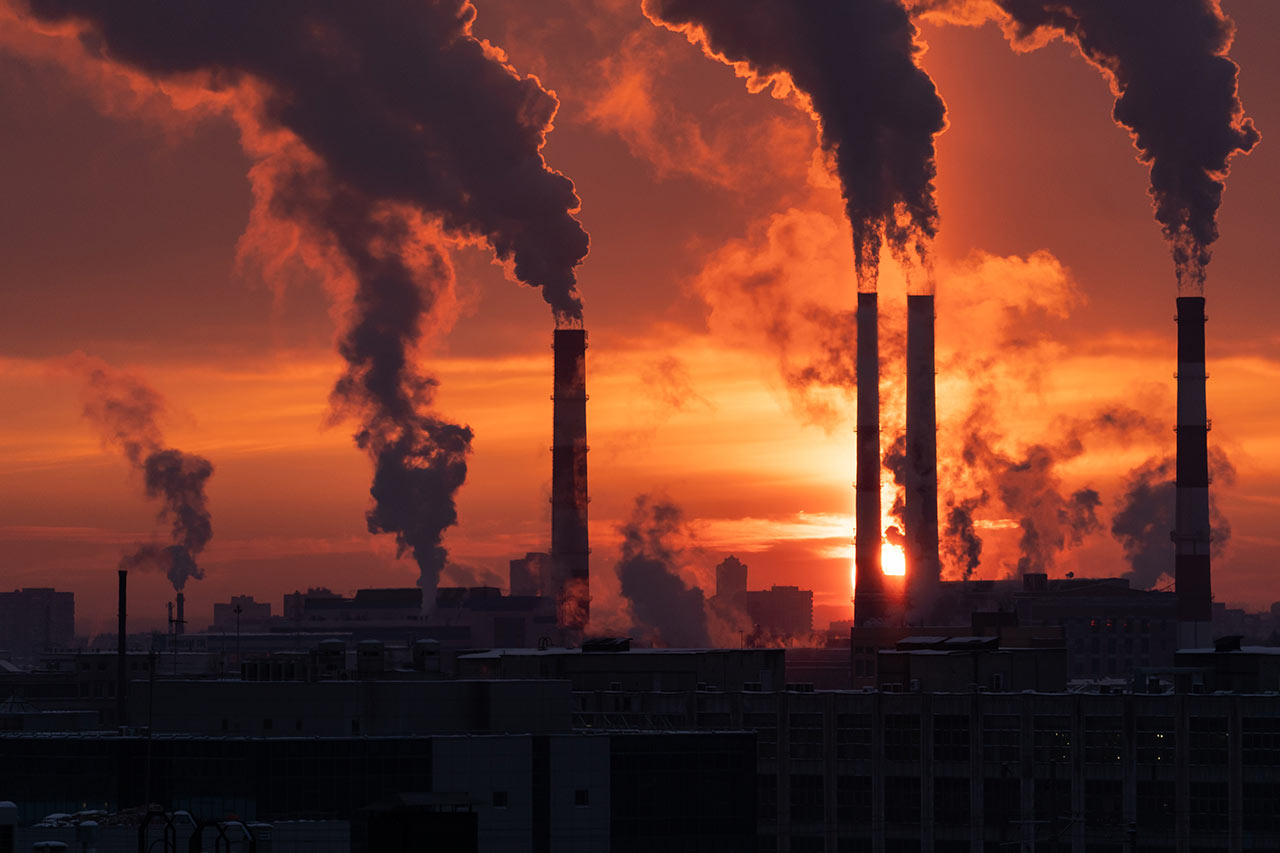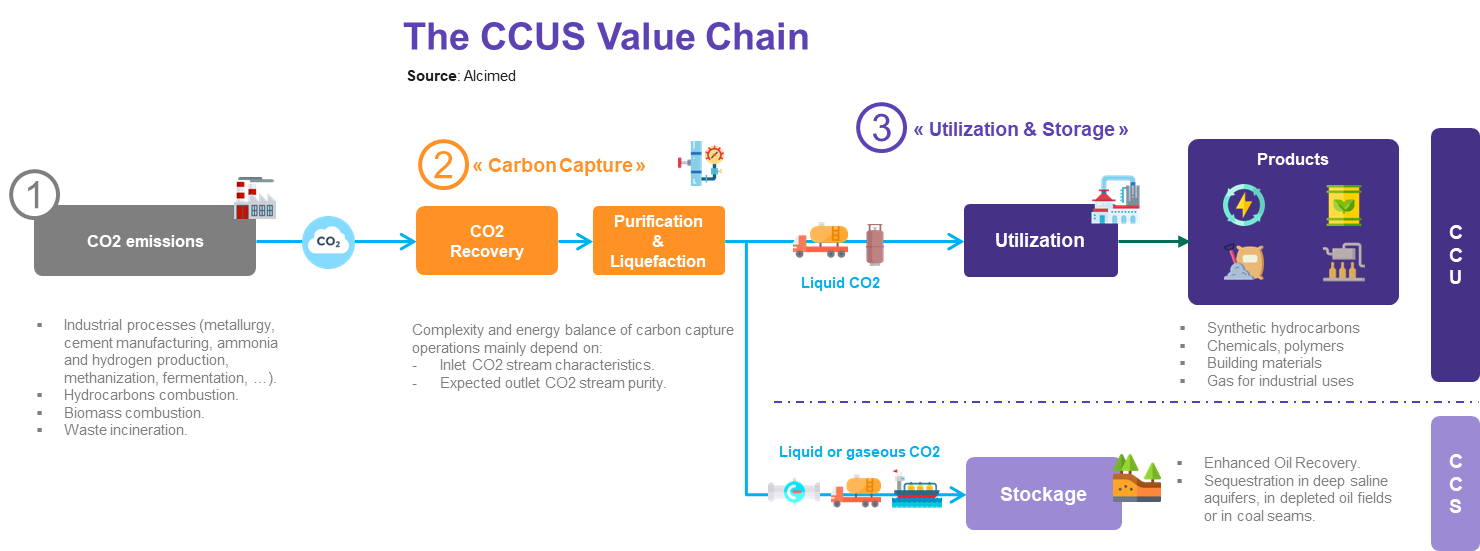CCUS technology: CO2 as a resource or a waste?

Carbon Capture, Utilization and Storage, or CCUS, is in the spotlight nowadays in the industry. Still, between utilization – that consists in reusing the CO2 as a feedstock in the industry – and storage – that consists in sequestering it in the subsurface – the gap is considerable. Of course, utilization and storage are complementary pathways in certain respects. According to the specific features of a given stream of CO2, one pathway can be more suitable than the other. However, behind these two solutions lie two distinct visions of how to reduce carbon footprint. Alcimed shares some tracks of reflection.
The promises of CCUS in the Energy, Chemical and Construction Sectors
On the one hand, there is CCU: we reuse in the industry the CO2 that was emitted… by the industry itself. CCU has been a reality for many years! Yet, some game-changing technologies arise, allowing the economically sustainable capture of diluted CO2 streams, such as the CO2 from a cement factory or a refinery. A recent technology, called “Direct Air Capture”, even allows the capture of atmospheric CO2. Moreover, promising market opportunities in various sectors (energy, chemistry, construction) are under development.
On the other hand, there is CCS: we capture CO2, not for reuse purposes, but for plain and simple underground sequestration. There are indeed hermetic geological sites, such as deep saline aquifers or depleted oil fields, where one can store CO2 with the insurance of having it stay in the subsurface for thousands of years – as long as the site is well-chosen and injection operations, carefully monitored.
Learn more about carbon neutrality and low carbon strategies >
CCS: a “must-have” to reach carbon neutrality?
Let us focus on CCS. Storing CO2 and thus removing it permanently from the atmosphere could indeed help us reach the targets of COP21 to stem global warming. In May 2019, the British Committee on Climate Change acknowledged that “CCS is a necessity not an option for reaching net-zero greenhouse gas emissions” [1].
The good news is that storage capacities are huge. Global capacity of deep saline aquifers worldwide is estimated at 10,000 gigatons of CO2 [2]. This would mean 300 years of storage if gobal CO2 emissions remain at the 2019 level (33,3 gigatons of CO2 from the use of fossil resources and from the industry [3]).
Large Oil & Gas companies have clearly understood that there was a potential business model in storing other stakeholders’ CO2. Thus, in each large, European CCS project, there is a big Oil & Gas player: Energie Beheer Nederland (EBN) for Rotterdam CCUS, Total for « DMX (TM) Demonstration in Dunkirk » (3D), Shell, Total and Equinor for the « Northern Lights » project in Norway.
There are yet barriers to overcome. Economically, for most CO2 sources, capture and storage costs are still much higher than carbon taxes. From a regulatory standpoint, some protocols and international agreements hamper CO2 cross-border transport. Above all, there are legitimate societal concerns about the sustainability of a technology that, for many, has some common ground with the landfill of waste.
High costs and lack of market opportunities: the road ahead of CCU is still long
Another solution could lie in CCU. Direct use in beverage carbonation is a traditional application for captured CO2 but has very short storage time since CO2 is soon released in the atmosphere. One should rather have a look on new CO2 conversion technologies that are being developed and will shape the future of CCU. In the energy sector, for instance, CO2 can be used as a feedstock to synthetize hydrocarbons such as methane or methanol. CO2 is also used as a chemical reagent in organic synthesis, to produce compounds such as polymers or inorganic carbonates. In the construction industry, some players use CO2 to manufacture “carbon-negative” building materials, and to accelerate concrete curing while using less cement.
Many of these technologies are extremely promising. Though, when it comes to “absorbing” the vast quantities of CO2 from industry emissions, two major issues arise. First, the costs: making synthetic methane out of CO2 and “green” hydrogen is still much more expensive than extracting natural gas. Secondly, the market demand to absorb the quantities of CO2 emitted. In CO2 chemistry, market applications are not unbounded. Some projections have even shown that turning the amounts of CO2 from a large bioethanol plant into sodium bicarbonate would exceed the French market demand for this product!
CCS remains the solution to absorb and sequester large quantities of “waste-CO2”. In other words, to get rid of it as we do with factory effluents. That is one step towards net-zero carbon dioxide emissions, likely to be necessary to help restricting global rise of temperatures. Nevertheless, with the development of CCU, a real circular economy is created, where the CO2 our industry emits will become a resource. CCU needs research efforts to support its development and improve technologies. It also needs incentive mechanisms to make these technologies economically sustainable. And above all, CCU needs a transition of our whole economy, so dependent on fossil resources that there is little space for the rise of carbon dioxide chemistry. Hopefully, the latter will gain ground against petrochemistry in the years to come.
About the author
Thibault, Senior Consultant, Alcimed Industries Paris Office
[1] Net Zero – The UK’s contribution to stopping global warming. Committee on Climate Change, May 2019.
[2] Leung et al, 2014.
[3] Defying expectations of a rise, global carbon dioxide emissions flatlined in 2019. 11 February 2020.
Do you have an exploration project?
Our explorers are ready to discuss it with you
